tow TOYOTA YARIS 2020 Owners Manual
[x] Cancel search | Manufacturer: TOYOTA, Model Year: 2020, Model line: YARIS, Model: TOYOTA YARIS 2020Pages: 692, PDF Size: 68.71 MB
Page 3 of 692

3
1
7
8
6
5
4
3
2
9
YARIS_F_OM_Europe_OM52A54E
3-1. Key information
Keys ...................................142
3-2. Opening, closing
and locking the doors
Side doors..........................154
Back door...........................161
Smart entry & start
system .............................167
3-3. Adjusting the seats
Front seats .........................198
Rear seats .........................201
Head restraints ..................204
3-4. Adjusting the steering
wheel and mirrors
Steering wheel ...................207
Inside rear view mirror .......209
Outside rear view
mirrors .............................211
3-5. Opening and closing
the windows
Power windows ..................214
4-1. Before driving
Driving the vehicle ............. 220
Cargo and luggage............ 230
Trailer towing..................... 231
4-2. Driving procedures
Engine (ignition) switch
(vehicles without
a smart entry &
start system) ................... 241
Engine (ignition) switch
(vehicles with
a smart entry &
start system) ................... 243
Multidrive ........................... 252
Manual transmission ......... 260
Turn signal lever................ 264
Parking brake .................... 265
4-3. Operating the lights
and wipers
Headlight switch ................ 266
Fog light switch ................. 271
Windshield wiper and
washer ............................ 273
Rear window wiper and
washer ............................ 277
4-4. Refueling
Opening the fuel tank
cap .................................. 279
3Operation of
each component4Driving
Page 6 of 692

TABLE OF CONTENTS6
YARIS_F_OM_Europe_OM52A54E
6-4. Using the other interior
features
Other interior features ........470
• Sun visors ......................470
• Vanity mirrors ................470
• Portable ashtray ............472
• Cigarette lighter .............473
• Power outlet ..................474
• Armrest ..........................475
• Panoramic roof shade ...475
• Assist grips ....................476
7-1. Maintenance and care
Cleaning and protecting
the vehicle exterior ..........478
Cleaning and protecting
the vehicle interior ...........482
7-2. Maintenance
Maintenance
requirements....................485
7-3. Do-it-yourself maintenance
Do-it-yourself service
precautions ......................488
Hood ..................................491
Positioning a floor jack .......493
Engine compartment ......... 495
Tires .................................. 508
Tire inflation pressure........ 528
Wheels .............................. 530
Air conditioning filter .......... 534
Wireless remote control/
electronic key battery ...... 537
Checking and replacing
fuses ............................... 541
Light bulbs ......................... 547
8-1. Essential information
Emergency flashers .......... 568
If your vehicle has to
be stopped in
an emergency ................. 569
If the vehicle is
trapped in rising water..... 571
8-2. Steps to take in
an emergency
If your vehicle needs to
be towed ......................... 572
If you think something is
wrong .............................. 579
Fuel pump
shut off system ............... 580
7Maintenance and care8When trouble arises
Page 16 of 692

16Pictorial index
YARIS_F_OM_Europe_OM52A54E
■Instrument panel (Left-hand drive vehicles)
Engine switch . . . . . . . . . . . . . . . . . . . . . . . . . . . . . . . . P. 241, 243
Starting the engine . . . . . . . . . . . . . . . . . . . . . . . . . . . . . P. 241, 243
Changing engine switch positions/modes . . . . . . . . . . . . P. 241, 245
Emergency stop of the engine . . . . . . . . . . . . . . . . . . . . . . . . . P. 569
When the engine will not start . . . . . . . . . . . . . . . . . . . . . . . . . P. 629
Warning lights*1, 2/warning messages*1, 3. . . . . . . . . . . P. 590, 592
Shift lever . . . . . . . . . . . . . . . . . . . . . . . . . . . . . . . . . . . . P. 252, 260
Changing the shift position . . . . . . . . . . . . . . . . . . . . . . . P. 252, 260
Precautions against towing . . . . . . . . . . . . . . . . . . . . . . . . . . . P. 572
When the shift lever does not move*4. . . . . . . . . . . . . . . . . . . P. 257
Meters . . . . . . . . . . . . . . . . . . . . . . . . . . . . . . . . . . . . . . . P. 115, 118
Reading the meters . . . . . . . . . . . . . . . . . . . . . . . . . . . . . .P. 115, 118
Adjusting the instrument cluster light . . . . . . . . . . . . . . . . P. 116, 120
Warning lights/indicators . . . . . . . . . . . . . . . . . . . . . . . . . . . . . P. 108
When the warning lights come on . . . . . . . . . . . . . . . . . . . . . . P. 581
1
2
3
Page 24 of 692
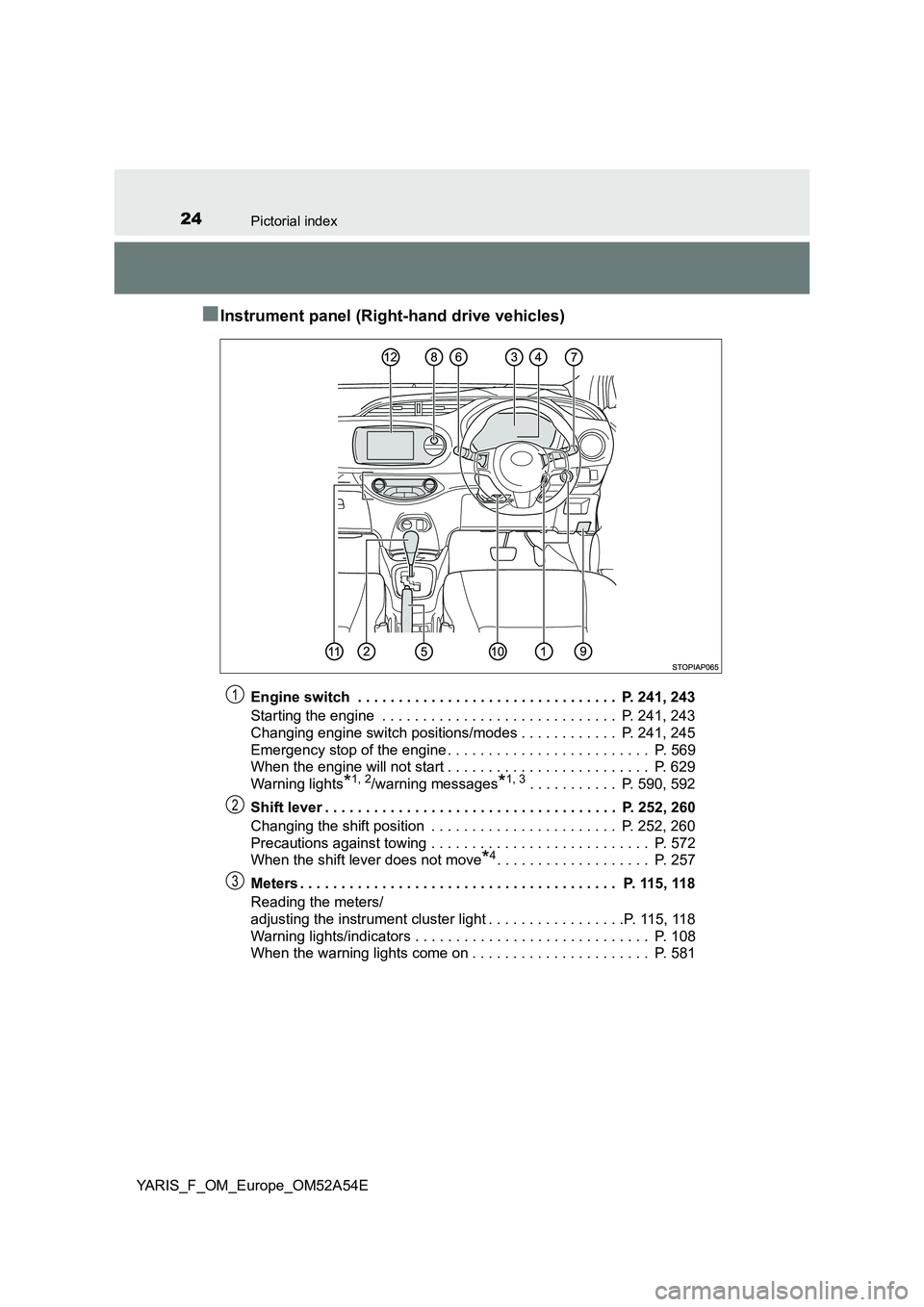
24Pictorial index
YARIS_F_OM_Europe_OM52A54E
■Instrument panel (Right-hand drive vehicles)
Engine switch . . . . . . . . . . . . . . . . . . . . . . . . . . . . . . . . P. 241, 243
Starting the engine . . . . . . . . . . . . . . . . . . . . . . . . . . . . . P. 241, 243
Changing engine switch positions/modes . . . . . . . . . . . . P. 241, 245
Emergency stop of the engine . . . . . . . . . . . . . . . . . . . . . . . . . P. 569
When the engine will not start . . . . . . . . . . . . . . . . . . . . . . . . . P. 629
Warning lights*1, 2/warning messages*1, 3. . . . . . . . . . . P. 590, 592
Shift lever . . . . . . . . . . . . . . . . . . . . . . . . . . . . . . . . . . . . P. 252, 260
Changing the shift position . . . . . . . . . . . . . . . . . . . . . . . P. 252, 260
Precautions against towing . . . . . . . . . . . . . . . . . . . . . . . . . . . P. 572
When the shift lever does not move*4. . . . . . . . . . . . . . . . . . . P. 257
Meters . . . . . . . . . . . . . . . . . . . . . . . . . . . . . . . . . . . . . . . P. 115, 118
Reading the meters/
adjusting the instrument cluster light . . . . . . . . . . . . . . . . .P. 115, 118
Warning lights/indicators . . . . . . . . . . . . . . . . . . . . . . . . . . . . . P. 108
When the warning lights come on . . . . . . . . . . . . . . . . . . . . . . P. 581
1
2
3
Page 40 of 692
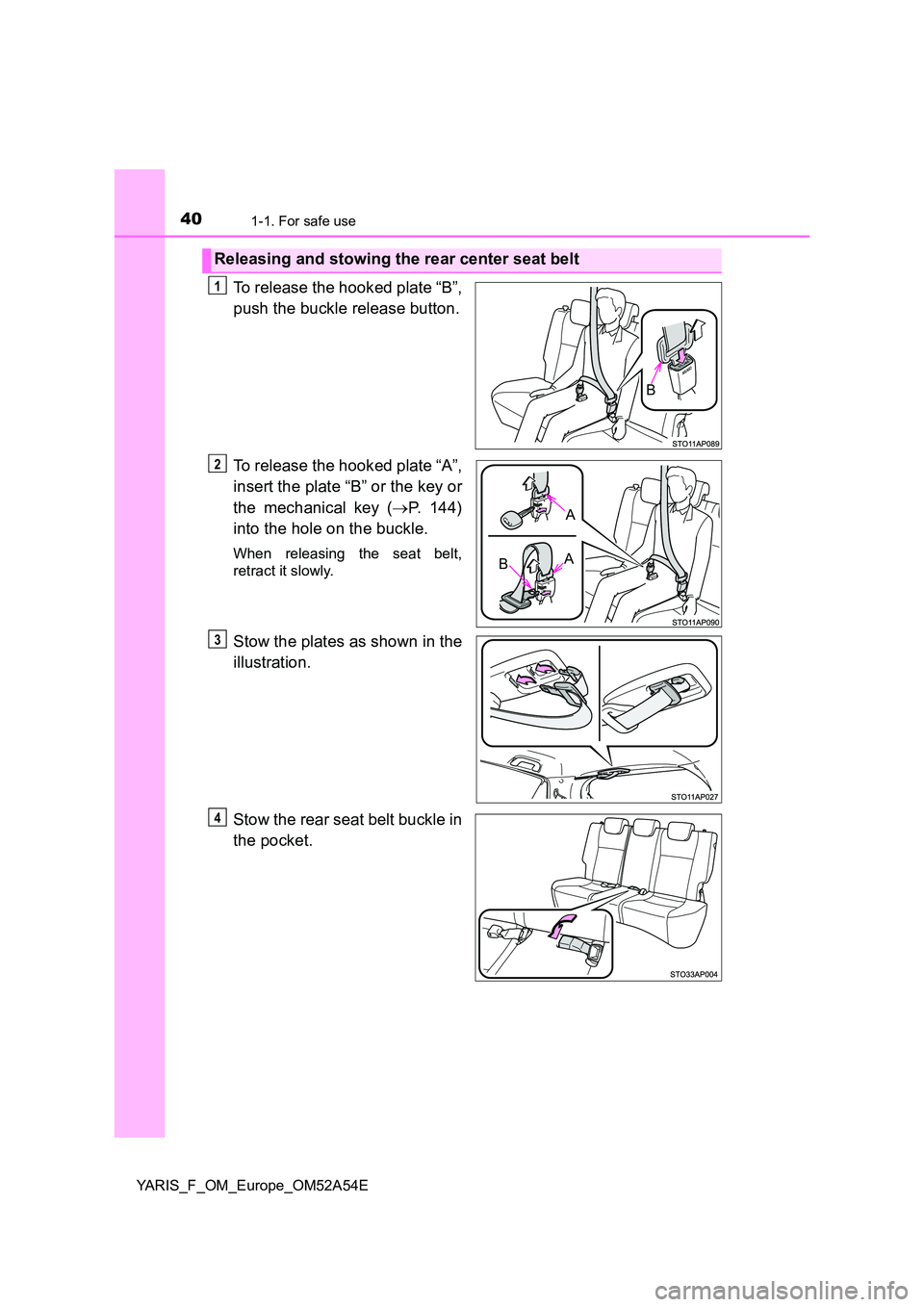
401-1. For safe use
YARIS_F_OM_Europe_OM52A54E
To release the hooked plate “B”,
push the buckle release button.
To release the hooked plate “A”,
insert the plate “B” or the key or
the mechanical key ( P. 144)
into the hole on the buckle.
When releasing the seat belt,
retract it slowly.
Stow the plates as shown in the
illustration.
Stow the rear seat belt buckle in
the pocket.
Releasing and stowing the rear center seat belt
B
1
A
BA
2
3
4
Page 47 of 692

471-1. For safe use
1
For safety and security
YARIS_F_OM_Europe_OM52A54E
The main SRS airbag system components are shown above. The
SRS airbag system is controlled by the airbag sensor assembly. As
the airbags deploy, a chemical reaction in the inflators quickly fills the
airbags with non-toxic gas to help restrain the motion of the occu-
pants.
WARNING
■ SRS airbag precautions
Observe the following precautions regarding the SRS airbags.
Failure to do so may cause death or serious injury.
● The driver and all passengers in the vehicle must wear their seat belts
properly.
The SRS airbags are supplemental devic es to be used with the seat belts.
● The SRS driver airbag deploys with considerable force, and can cause
death or serious injury especially if the driver is very close to the airbag.
Since the risk zone for the driver’s airbag is the first 50 - 75 mm (2 - 3 in.)
of inflation, placing yourself 250 mm ( 10 in.) from your driver airbag pro-
vides you with a clear margin of safety. This distance is measured from
the center of the steering wheel to your breastbone. If you sit less than
250 mm (10 in.) away now, you can change your driving position in sev-
eral ways:
• Move your seat to the rear as far as you can while still reaching the ped-
als comfortably.
• Slightly recline the back of the seat. Although vehicle designs vary,
many drivers can achieve the 250 mm (10 in.) distance, even with the
driver seat all the way forward, simply by reclining the back of the seat
somewhat. If reclining the back of your seat makes it hard to see the
road, raise yourself by using a firm, non-slippery cushion, or raise the
seat if your vehicle has that feature.
• If your steering wheel is adjustable, tilt it downward. This points the
airbag toward your chest instead of your head and neck.
The seat should be adjusted as recommended above, while still maintain-
ing control of the foot pedals, steering wheel, and your view of the instru-
ment panel controls.
Page 49 of 692
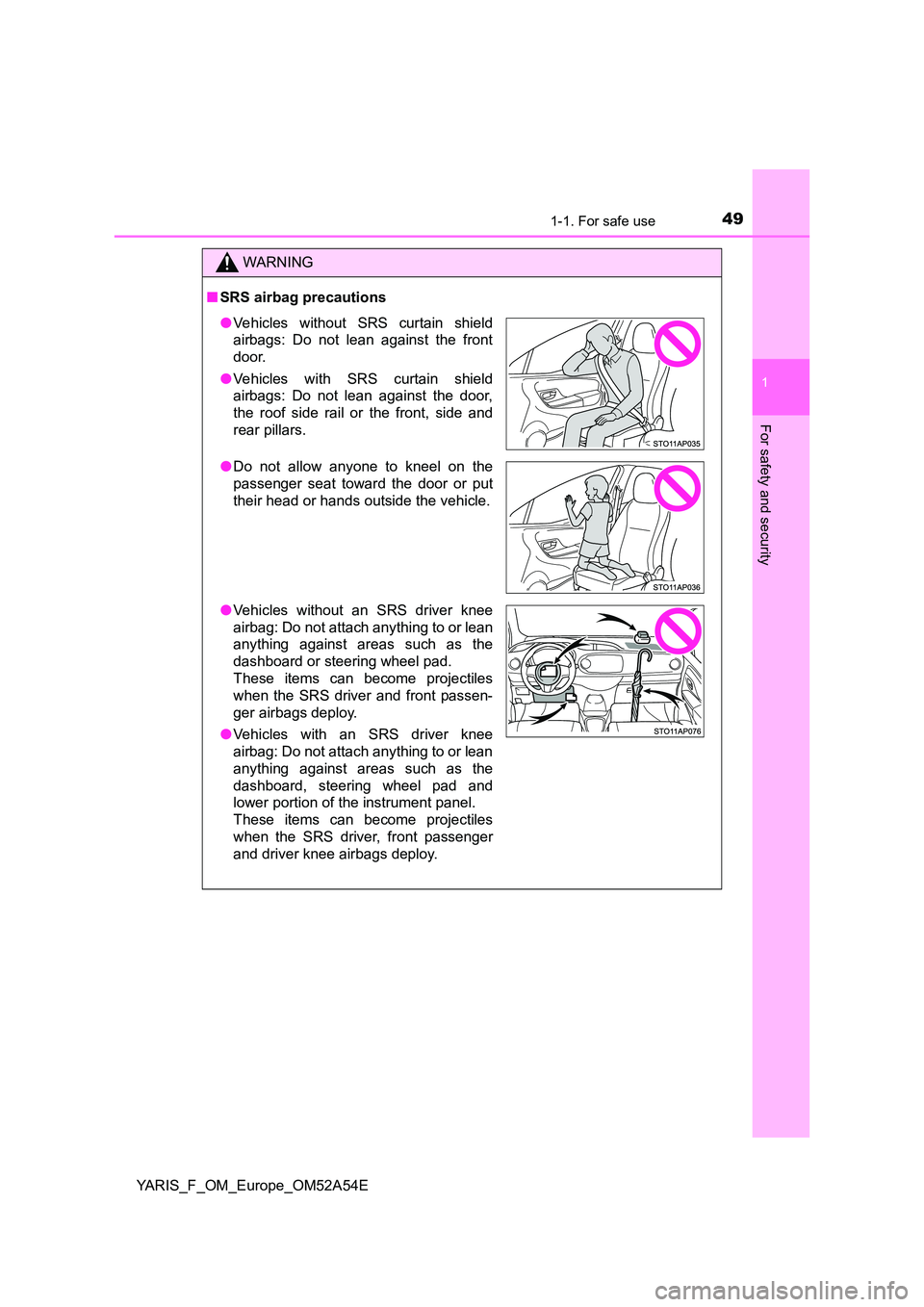
491-1. For safe use
1
For safety and security
YARIS_F_OM_Europe_OM52A54E
WARNING
■SRS airbag precautions
●Vehicles without SRS curtain shield
airbags: Do not lean against the front
door.
● Vehicles with SRS curtain shield
airbags: Do not lean against the door,
the roof side rail or the front, side and
rear pillars.
● Do not allow anyone to kneel on the
passenger seat toward the door or put
their head or hands outside the vehicle.
● Vehicles without an SRS driver knee
airbag: Do not attach anything to or lean
anything against areas such as the
dashboard or steering wheel pad.
These items can become projectiles
when the SRS driver and front passen-
ger airbags deploy.
● Vehicles with an SRS driver knee
airbag: Do not attach anything to or lean
anything against areas such as the
dashboard, steering wheel pad and
lower portion of the instrument panel.
These items can become projectiles
when the SRS driver, front passenger
and driver knee airbags deploy.
Page 79 of 692

791-2. Child safety
1
For safety and security
YARIS_F_OM_Europe_OM52A54E
■Removing a child restraint system installed with a seat belt
Press the buckle release button and fully retract the seat belt.
When releasing the buckle, the chil d restraint system may spring up due
to the rebound of the seat cushion. Release the buckle while holding
down the child restraint system.
Since the seat belt automatically reels itself, slowly return it to the stow-
ing position.
■ When installing a child restraint system
You may need a locking clip to install the child restraint system. Follow the
instructions provided by the manufacturer of the system. If your child restraint
system does not provide a locking clip, you can purchase the following item
from any authorized Toyota retailer or Toyota authorized repairer, or any reli-
able repairer: Locking clip for child restraint system
(Part No. 73119-22010)
Page 144 of 692
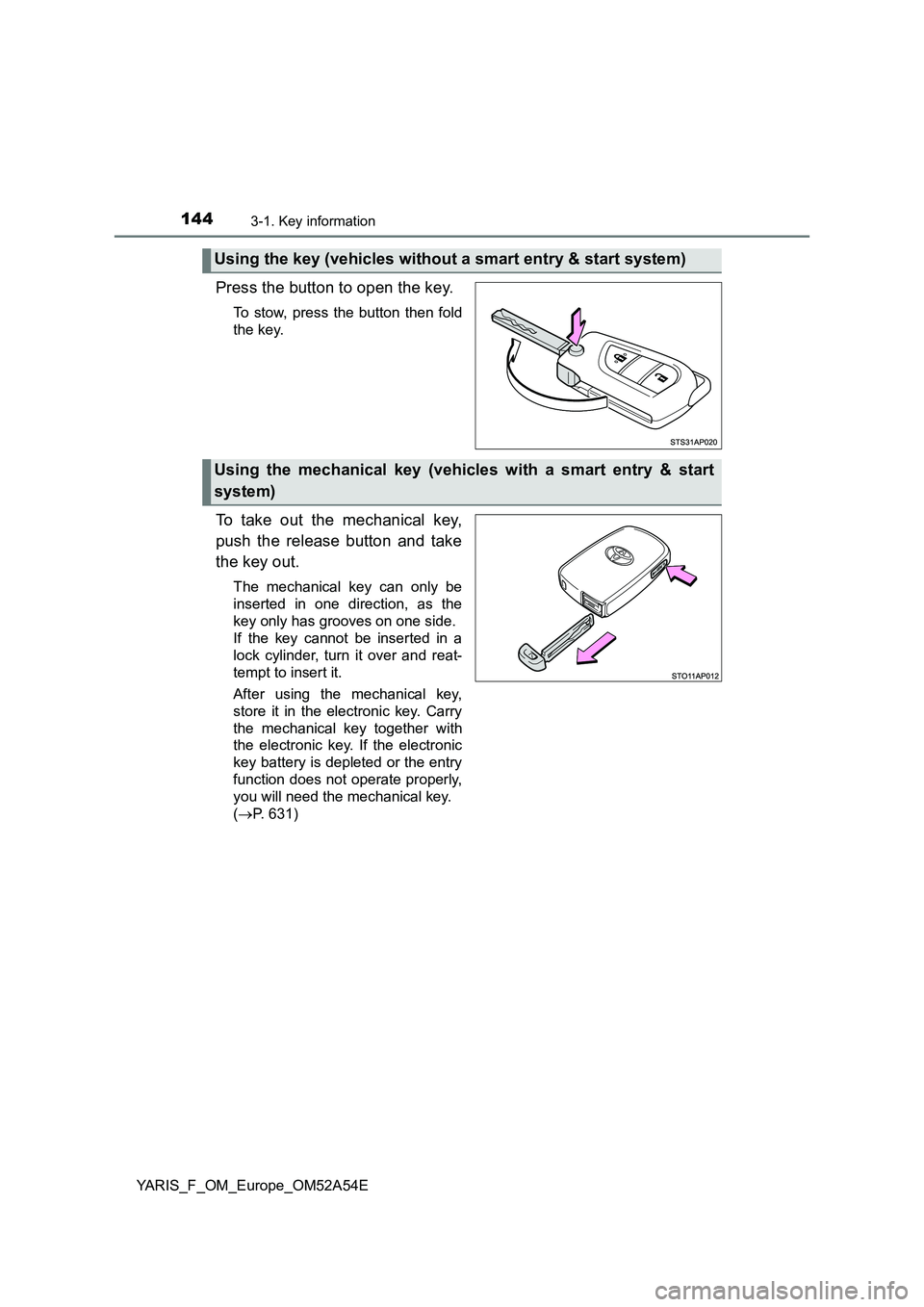
1443-1. Key information
YARIS_F_OM_Europe_OM52A54E
Press the button to open the key.
To stow, press the button then fold
the key.
To take out the mechanical key,
push the release button and take
the key out.
The mechanical key can only be
inserted in one direction, as the
key only has grooves on one side.
If the key cannot be inserted in a
lock cylinder, turn it over and reat-
tempt to insert it.
After using the mechanical key,
store it in the electronic key. Carry
the mechanical key together with
the electronic key. If the electronic
key battery is depleted or the entry
function does not operate properly,
you will need the mechanical key.
( P. 631)
Using the key (vehicles without a smart entry & start system)
Using the mechanical key (vehicles with a smart entry & start
system)
Page 145 of 692
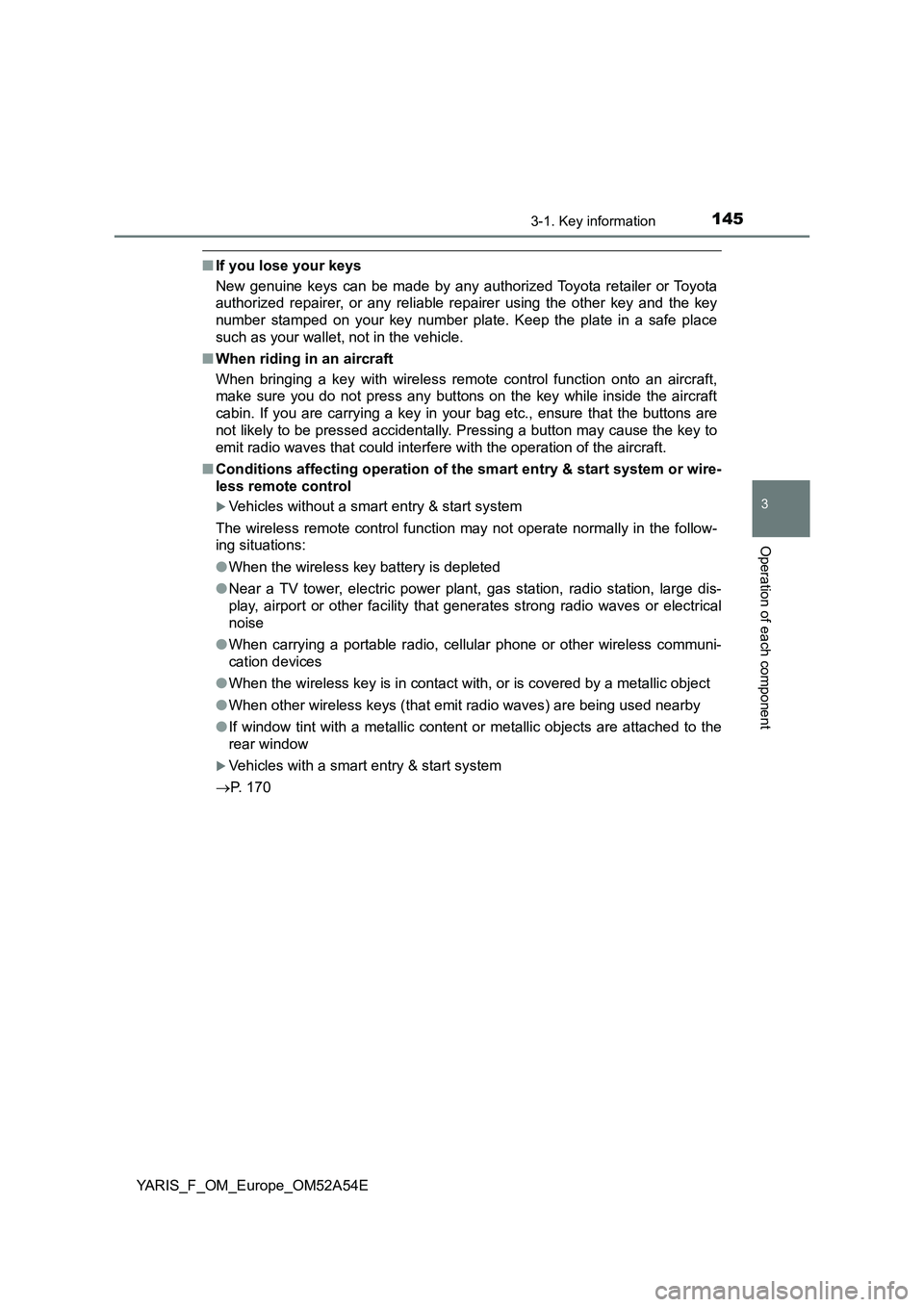
1453-1. Key information
3
Operation of each component
YARIS_F_OM_Europe_OM52A54E
■If you lose your keys
New genuine keys can be made by any authorized Toyota retailer or Toyota
authorized repairer, or any reliable repairer using the other key and the key
number stamped on your key number plate. Keep the plate in a safe place
such as your wallet, not in the vehicle.
■When riding in an aircraft
When bringing a key with wireless remote control function onto an aircraft,
make sure you do not press any buttons on the key while inside the aircraft
cabin. If you are carrying a key in your bag etc., ensure that the buttons are
not likely to be pressed accidentally. Pressing a button may cause the key to
emit radio waves that could interfere with the operation of the aircraft.
■Conditions affecting operation of the smart entry & start system or wire-
less remote control
Vehicles without a smart entry & start system
The wireless remote control function may not operate normally in the follow-
ing situations:
●When the wireless key battery is depleted
●Near a TV tower, electric power plant, gas station, radio station, large dis-
play, airport or other facility that generates strong radio waves or electrical
noise
●When carrying a portable radio, cellular phone or other wireless communi-
cation devices
●When the wireless key is in contact with, or is covered by a metallic object
●When other wireless keys (that emit radio waves) are being used nearby
●If window tint with a metallic content or metallic objects are attached to the
rear window
Vehicles with a smart entry & start system
P. 170